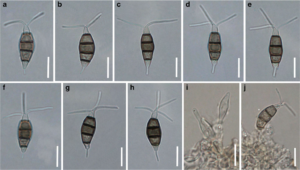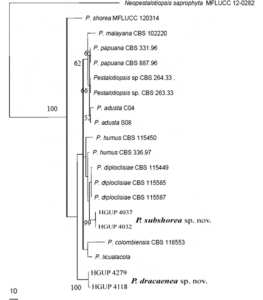Pestalotiopsis dracaenea Yong Wang bis, Yu Song, K. Geng & K.D. Hyde [as ‘dracaenea’], in Ariyawansa et al., Fungal Diversity: 10.1007/s13225-015-0346-5, [138] (2015)
Index Fungorum number: IF551444; Facesoffungi number: FoF01045; Fig. 1
Etymology – The specific epithet refers to the host, Dracaena fragrans, from which the taxon was isolated.
Holotype – HGUPd 4037 Associated with diseased leaves of Dracaena fragrans (L.) Ker Gawl. Sexual morph: undetermined. Asexual morph: Conidiophores indistinct. Conidiogenous cells lageniform. Conidia fusoid to ellipsoid, straight to slightly curved, 4-septate, 18–24×6.5–8.5 μm (x̄ = 20.5×7.5 μm), basal cell obconic, hyaline, thin-walled and verruculose, 3–4.5 μm long (x̄ = 4 μm), with three median cells, subcylindrical to cylindrical, verruculose, slightly constricted at the septa, concolourous, brown, together 11.5–16 μm long (x̄ = 13.5 μm) second cell from base 3.5–5.5 μm (x̄ = 4.5 μm); third cell 4–5.5 μm (x̄ = 5.5 μm); fourth cell 4–5.5 μm (x̄ = 4.5 μm); apical cell hyaline, obconic to subcylindrical, 3–5.5 μm long (x̄ = 4.4 μm); with 2–4 tubular appendages, 6.5–15.5 μm long (x̄ = 11 μm), arising from the apex of the apical cell, unequal; basal appendage present, filiform, 3–7 μm long (x̄ = 4.2 μm).
Culture characteristics: Colonies on PDA reaching 7 cm diam. after 7 days at 25 °C, edge crenate, whitish, with aerial mycelium on surface, with black, gregarious fruiting bodies; reverse of the culture white.
Material examined – CHINA, Hainan Province, Xinglong County, Tropical Botanical Garden, on living leaves of Dracaena fragrans (Asparagaceae), Kun Geng, 8 March 2012 (HGUP d4037, holotype); ex-type culture HGUP4037; CHINA, Hainan Province, Xinglong County, Tropical Botanic Garden, on living leaves of Dracaena fragrans, Kun Geng, 8 March 2012 (HGUP 4032, paratype).
Notes – We obtained two isolates of P. dracaenea (HGUP 4037 and HGUP 4032) which formed a relative independent branch with 100 % bootstrap value (Fig. 90), and had a close relationship with P. diploclisiae P. diploclisiae Maharachch., K.D. Hyde & Crous isolated on fruit of Diploclisia glaucescens and Psychotria tutcheri in Hong Kong, China and P. humus isolated on fruits of Llex cinerea in Hong Kong and soil in Papua New Guinea. Pestalotiopsis dracaenea differs from
P. humus Maharachch., K.D. Hyde & Crous (18.5– 22×5–7 μm) and P. diploclisiae (22–26.5×5–6.5 μm) by conidial morphology, viz. wider conidia (6.5–8.5 μm) and longer apical (6.5–15.5 μm long) and basal (3–7 μm) appendages for P. humus, but shorter apical appendages than P. diploclisiae (13–19 μm).

Fig. 1 Pestalotiopsis dracaenea (holotype) a–h Conidia i, j Conidiophores / conidiogenous cells. Scale bars=10 μm

Fig. 2 Phylogenetic tree for Pestalotiopsis based on combined sequences of ITS, β-tubulin and EF by Maximum Likelihood (ML) method on MEGA 6.0.
Bootstrap support values <50 % were not shown. The tree is rooted with Neopestalotiopsis saprophyta (MFLUCC 12-0282
